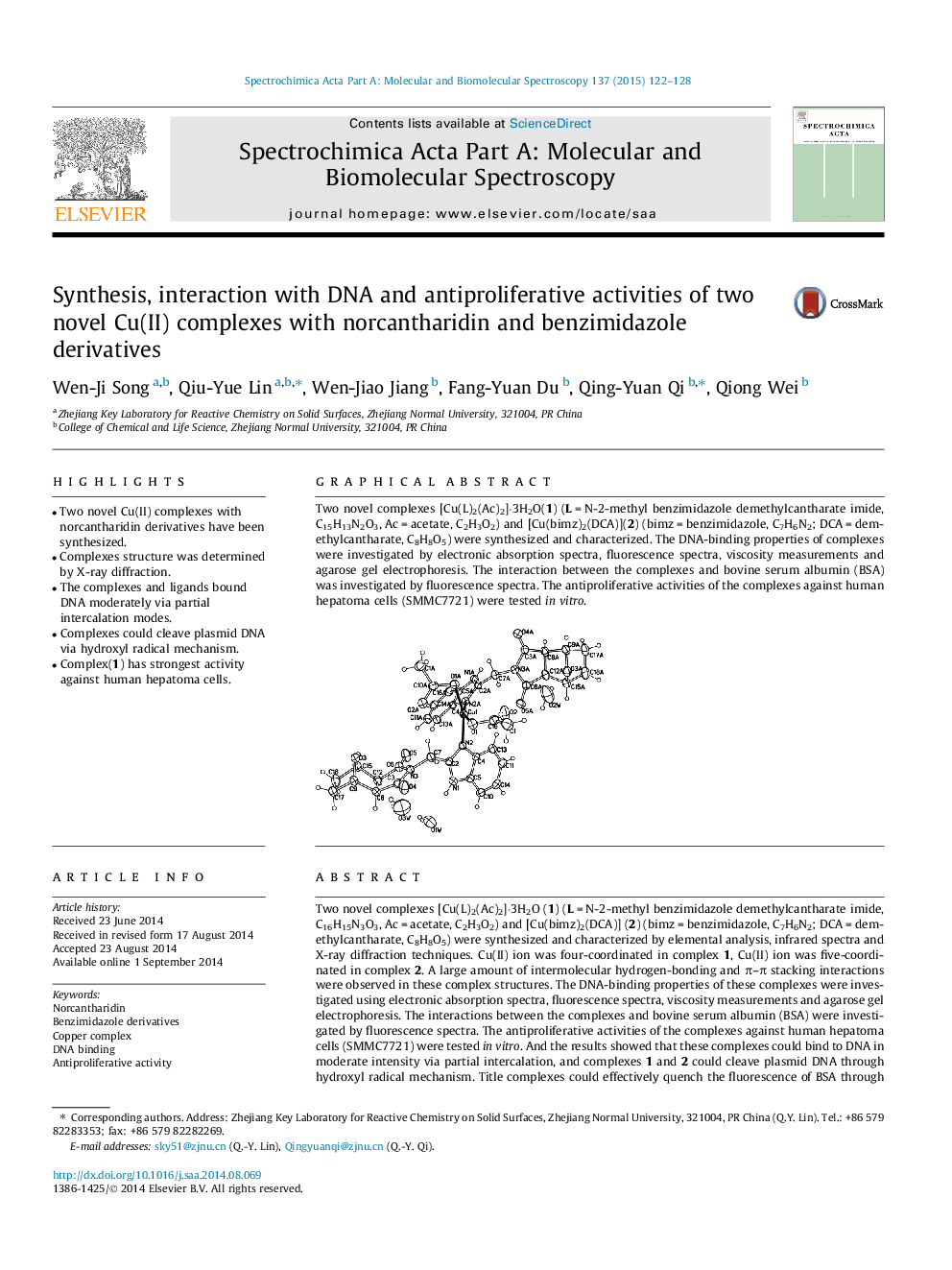| کد مقاله | کد نشریه | سال انتشار | مقاله انگلیسی | نسخه تمام متن |
|---|---|---|---|---|
| 1229223 | 1495232 | 2015 | 7 صفحه PDF | دانلود رایگان |

• Two novel Cu(II) complexes with norcantharidin derivatives have been synthesized.
• Complexes structure was determined by X-ray diffraction.
• The complexes and ligands bound DNA moderately via partial intercalation modes.
• Complexes could cleave plasmid DNA via hydroxyl radical mechanism.
• Complex(1) has strongest activity against human hepatoma cells.
Two novel complexes [Cu(L)2(Ac)2]·3H2O (1) (L = N-2-methyl benzimidazole demethylcantharate imide, C16H15N3O3, Ac = acetate, C2H3O2) and [Cu(bimz)2(DCA)] (2) (bimz = benzimidazole, C7H6N2; DCA = demethylcantharate, C8H8O5) were synthesized and characterized by elemental analysis, infrared spectra and X-ray diffraction techniques. Cu(II) ion was four-coordinated in complex 1, Cu(II) ion was five-coordinated in complex 2. A large amount of intermolecular hydrogen-bonding and π–π stacking interactions were observed in these complex structures. The DNA-binding properties of these complexes were investigated using electronic absorption spectra, fluorescence spectra, viscosity measurements and agarose gel electrophoresis. The interactions between the complexes and bovine serum albumin (BSA) were investigated by fluorescence spectra. The antiproliferative activities of the complexes against human hepatoma cells (SMMC7721) were tested in vitro. And the results showed that these complexes could bind to DNA in moderate intensity via partial intercalation, and complexes 1 and 2 could cleave plasmid DNA through hydroxyl radical mechanism. Title complexes could effectively quench the fluorescence of BSA through static quenching. Meanwhile, title complexes had stronger antiproliferative effect compared to L and Na2(DCA) within the tested concentration range. And complex 1 possessed more antiproliferative active than complex 2.
Two novel complexes [Cu(L)2(Ac)2]·3H2O(1) (L = N-2-methyl benzimidazole demethylcantharate imide, C15H13N2O3, Ac = acetate, C2H3O2) and [Cu(bimz)2(DCA)](2) (bimz = benzimidazole, C7H6N2; DCA = demethylcantharate, C8H8O5) were synthesized and characterized. The DNA-binding properties of complexes were investigated by electronic absorption spectra, fluorescence spectra, viscosity measurements and agarose gel electrophoresis. The interaction between the complexes and bovine serum albumin (BSA) was investigated by fluorescence spectra. The antiproliferative activities of the complexes against human hepatoma cells (SMMC7721) were tested in vitro.Figure optionsDownload as PowerPoint slide
Journal: Spectrochimica Acta Part A: Molecular and Biomolecular Spectroscopy - Volume 137, 25 February 2015, Pages 122–128